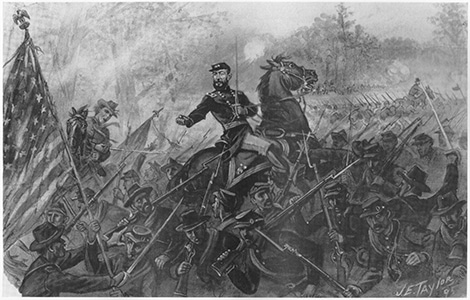No Photography: What Was a War Correspondent to Do?
Photography was in its rudimentary beginnings at the start of the Civil War, but the technology that would enable newspapers to print photographs on their pages wasn’t invented until 1881. However, the public was hungry for war news. Pencil and sketchpad in hand, artistic war correspondents rushed to fill the gap.
Twenty-four-year-old James Taylor was one such man. When Frank Leslie’s Illustrated Newspaper hired him to cover General Phil Sheridan’s Shenandoah Valley campaign in 1864, he was told the “importance of missing nothing, ‘not even sticks, stones and stumps’ to ensure the fidelity of his work—‘regardless of flying bullet and shell.’” Taylor dedicated himself to recording everything his eyes beheld while on assignment.
He had loved drawing since boyhood, saying that it “came as naturally as breathing.” War and battles had long filled his imagination. After serving in the Federal Army for two years as a soldier and being honorably discharged, he now had the opportunity to put his talents to work in the midst of the action.
Generals and other officers often enjoyed having their picture drawn, and a “special artist,” like Taylor and other correspondents, were often treated as minor celebrities around camp. But in the middle of war, officers had little time to see to the needs of a civilian. When Taylor asked for a horse to help him follow the army as they marched toward Winchester, Sheridan told him that he had none to spare. Taylor had to walk alongside the infantrymen until he was able to procure an animal for himself.
Then, there was the matter of how to get his drawings and news reports to his publisher in New York. Although Taylor occasionally hitched a ride with a supply train or accompanied a group of scouts, he often had to ride alone through miles of territory controlled by bushwhackers between Winchester and the working railroad in Harpers Ferry. He risked capture and imprisonment, and possibly death if Mosby or one of the other raiders decided to retaliate for the deaths of their own men. One time he raced to the safety of the Federal lines barely escaping the bushwhackers who were in hot pursuit.
After Sheridan and his men definitively defeated the Confederate at the Battle of Cedar Creek in October 1864 and devastated the valley, the newspaper transferred Taylor to Petersburg, VA to report on Grant’s ongoing siege. Shortly, thereafter, they sent him to Savannah so he could capture General Sherman’s march through the Carolinas.
With his pencil as his camera lens, he recorded the skirmishes, marches, and the burning of Columbia, SC. Eager to be at the heart of the action even as the war drew to a close, Taylor sneaked onto Sherman’s train in April 1865 in hopes of being an eye witness to the surrender of General Joseph Johnston. However, Sherman discovered the stowaway, stopped the train, and had Taylor kicked off. He had to draw his sketches of the event from second-hand reports.
After the war, Taylor toured the South for a year, drawing former slaves, and then ventured West for another year recording what his eyes beheld. In addition, he continued to draw portraits of generals for years afterward. But he is probably best known for his work as a Civil War correspondent, especially for his sketches from the Shenandoah Valley Campaign.
Taylor was a man of adventure who sought to capture his world with his pencil, persevering snapshots of history and ordinary people for posterity.
How were the sketches transferred to newspaper print: Publishers hired wood engravers to copy/draw the images onto wooden blocks and chisel away the wood, surrounding the drawings.
SOURCE:
Jensen, Oliver. “War Correspondent 1864: The Sketchbooks of James E. Taylor. American Heritage, vol. 31, no. 5, August/September 1980.
https://www.americanheritage.com/war-correspondent-1864-sketchbooks-james-e-taylor


He didn’t miss a twig.
Ha:) I’ve seen his sketchbook of the Shenandoah Valley, and I believe it’s better than photos when it comes to capturing the area and the people in 1864. So no twig left unturned:)
Loved this post! Never thought about how the pictures came about and the hardships the artist might have endured. Taylor was a courageous and talented man! Thanks for sharing this info! 🙂
Yes, I was impressed with everything he was willing to go through in order to capture history in the making. His pencil must have moved as quickly as the keys on a keyboard with all of the magnificent detail he captured.
Fascinating. Thanks for this story.
You’re welcome:) Thanks for stopping by.